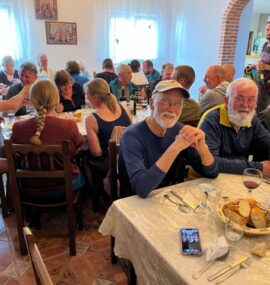As you know, Keep Moving might be the single most important healthy lifestyle choice that you can embrace and incorporate into your daily life. Last week, my wife, Betsy, and I returned from Spain after hiking the Camino de Santiago (also known as the Camino Frances). We started on April 21 in St. Jean Pied de Port, France, near the border with Spain, and finished at Santiago de Compostela on May 24. We walked 484 miles over 34 days. Since we had another week before our return plane trip to the US, we hiked another 52 miles over 4 more days on the Camino Finisterre from Santiago to the Atlantic Ocean. We kept moving during those six weeks at what I (and I suspect and our fellow hikers, aka pilgrims) regarded as a moderate pace for about 6 hours each day.
Getting lots of physical activity isn’t the only health benefit of walking the Camino de Santiago. Enjoying the camaraderie of other pilgrims counts for a lot. Betsy and I (like other pilgrims) made friends with other hikers along the way. When we’d meet later on the route, we’d swap stories of our journey and enjoy each other’s company. We looked forward to communal meals we shared with our comrades at albergues (hostels) where we stayed along the route. The lasting enjoyment and memories of walking the Camino will probably arise from the human connections we made along the way. This isn’t surprising given the importance of Cultivate Social Connections as a healthy lifestyle choice. Robert Waldinger and Marc Schulz marshal massive evidence from the most intensive study of adults ever conducted (the Harvard Study of Adult Development) in their new book, The Good Life, to support their contention that developing warm social relationships is the best thing you can do to create the good life.
The film, The Way, with Martin Sheen, features the Camino Santiago. For many pilgrims, walking the Camino is a profound spiritual or religious experience. Some pilgrims use their time on the Camino to come to terms with an emotional trauma, such as divorce or loss of a loved one, or another type of life transition. Others want to experience the culture of northern Spain. Still others want the adventure of a long-distance hike. Walking the Camino can also help pilgrims understand what’s important to them and to find greater purpose and meaning in life.
You may think that such an adventure works only for the hardiest souls and certainly not for seniors. Actually, based our experience, I’d say that those in the 55-70 year age range comprised the greatest proportion of the pilgrims in any 15-year age range.
If you’re looking for something completely different, consider walking one the 11 Camino routes in Europe. You can find full-length films, plenty of youtube videos, books of first-person accounts of the Camino de Santiago, guidebooks, and websites. The other Caminos tend to have less media coverage and likely fewer pilgrims. If you want to chat about the Camino de Santiago, send me an email via the contact page on my website, alantcarpenter.com. I’d be delighted to share my Camino experiences with you. During our walk. I posted weekly on The Trek website. You can find detailed descriptions of our days for week 2 or week 3 or for week 4 or for week 5. Buen camino!








